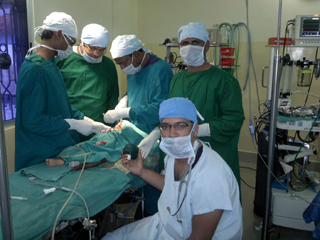
Smile Train's Cleft lip and palate teaching camp in Rajsthan Seva Sadan Hospital. (Photo courtesy of Sadasiv Swain via Flickr. License: CC-BY.)
Predicting Outcomes
In 2010, one of the organizations we looked at from the outside was Smile Train, which does cleft pallet surgery and cleft lip surgery and repair. The students made a prediction based on their analysis that Smile Train would run out of clefts to repair, and they were correct.
So the CEO of Smile Train, Brian Mulaney, saw the analysis and contacted me. He said, you're right – we did run out. I'm switching my strategy. Then he came to our class the following year, and gave a DILS talk in the fall. So we built a relationship. He is now the CEO of Wonder Work, and has brought in projects to GlobalHealth Lab. He attended the finale of 15.232.
It made me realize, though we certainly have organizations that have thanked us for the analysis, to be able to predict is pretty exciting. I've also used some of the student analyses as resources in other classes, like GlobalHealth Lab.
Generating Content that Is Useful to the Broader World
I love the idea of a classroom course generating a stream of content that others can use. In higher education we often have very skilled people taking classes and creating content that actually could help the world in some way, but it just gets put in the recycling bin. Even if chances are slim that one particular assignment will change the world, collectively we can design assignments that add up to a body of knowledge that others can draw on. I don't understand why we don't have a more efficient knowledge-sharing system there.
...how we leverage the work our students are doing to create usable and useful content for the world is a huge frontier for higher education...
If you look at the list of projects covered in 15.232, and add that to the 70 projects in GlobalHealth Lab, there is a huge depth of content. I feel very strongly that thinking about how we leverage the work our students are doing to create usable and useful content for the world is a huge frontier for higher education, especially in professional education.
There has been a lot of interest in that dummy deck because it lays out the basics for how you should describe a business model. I'm realizing that doesn't really exist anywhere, so that's a very sought-after thing. People who have start-ups or who are entering a chosen field of work have no guide for answering these questions that are inherent in developing a viable approach.
So we use the dummy deck to analyze organizations from the outside. But you could flip it and turn it into a planning or analysis tool, for somebody who's trying to figure out how to invest. I've talked to investors, entrepreneurs, and I've had a lot of requests from the outside on those fronts, which is interesting. There's some structure in there that I'd really like to build on, and I think could be useful to many.
Collaborating and Making Connections
Now I'm an advisor to Wonder Work, and we're working with organizations that Wonder Work is funding. In GlobalHealth Lab, our projects are enabling the partner organization to benefit from funding, which is a huge impact. Our direct advice not only may help the doctors, staff and patients, but it paves the way for third parties to give more, which is a huge multiplier effect.
This dynamic has also worked the other way. I've had partners in GlobalHealth Lab that we’ve studied in both classes who now get funding from Wonder Work because I introduced them. We open these dialogues, and then we have a chance to keep finding ways to connect with each other.
This is why I know it's great to teach at MIT because you're in this position where you can talk to people. They will reply to an email, take your call, or you can go visit folks, which is really amazing. So I feel very lucky to have this perch, and I feel like part of my duty then is to connect people and ideas as best I can.
